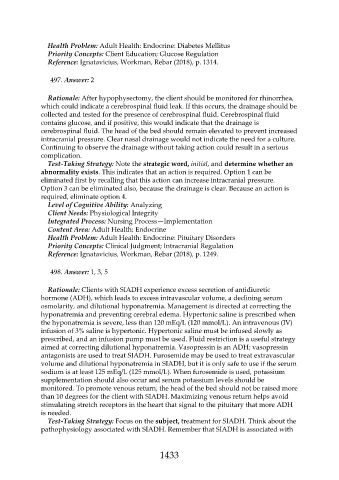Page 1433 - Saunders Comprehensive Review For NCLEX-RN
P. 1433
Health Problem: Adult Health: Endocrine: Diabetes Mellitus
Priority Concepts: Client Education; Glucose Regulation
Reference: Ignatavicius, Workman, Rebar (2018), p. 1314.
497. Answer: 2
Rationale: After hypophysectomy, the client should be monitored for rhinorrhea,
which could indicate a cerebrospinal fluid leak. If this occurs, the drainage should be
collected and tested for the presence of cerebrospinal fluid. Cerebrospinal fluid
contains glucose, and if positive, this would indicate that the drainage is
cerebrospinal fluid. The head of the bed should remain elevated to prevent increased
intracranial pressure. Clear nasal drainage would not indicate the need for a culture.
Continuing to observe the drainage without taking action could result in a serious
complication.
Test-Taking Strategy: Note the strategic word, initial, and determine whether an
abnormality exists. This indicates that an action is required. Option 1 can be
eliminated first by recalling that this action can increase intracranial pressure.
Option 3 can be eliminated also, because the drainage is clear. Because an action is
required, eliminate option 4.
Level of Cognitive Ability: Analyzing
Client Needs: Physiological Integrity
Integrated Process: Nursing Process—Implementation
Content Area: Adult Health: Endocrine
Health Problem: Adult Health: Endocrine: Pituitary Disorders
Priority Concepts: Clinical Judgment; Intracranial Regulation
Reference: Ignatavicius, Workman, Rebar (2018), p. 1249.
498. Answer: 1, 3, 5
Rationale: Clients with SIADH experience excess secretion of antidiuretic
hormone (ADH), which leads to excess intravascular volume, a declining serum
osmolarity, and dilutional hyponatremia. Management is directed at correcting the
hyponatremia and preventing cerebral edema. Hypertonic saline is prescribed when
the hyponatremia is severe, less than 120 mEq/L (120 mmol/L). An intravenous (IV)
infusion of 3% saline is hypertonic. Hypertonic saline must be infused slowly as
prescribed, and an infusion pump must be used. Fluid restriction is a useful strategy
aimed at correcting dilutional hyponatremia. Vasopressin is an ADH; vasopressin
antagonists are used to treat SIADH. Furosemide may be used to treat extravascular
volume and dilutional hyponatremia in SIADH, but it is only safe to use if the serum
sodium is at least 125 mEq/L (125 mmol/L). When furosemide is used, potassium
supplementation should also occur and serum potassium levels should be
monitored. To promote venous return, the head of the bed should not be raised more
than 10 degrees for the client with SIADH. Maximizing venous return helps avoid
stimulating stretch receptors in the heart that signal to the pituitary that more ADH
is needed.
Test-Taking Strategy: Focus on the subject, treatment for SIADH. Think about the
pathophysiology associated with SIADH. Remember that SIADH is associated with
1433

